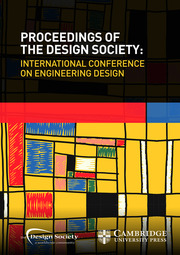Article contents
Exploitation of AM-Potentials by Linking Manufacturing Processes to Function-Driven Product Design
Published online by Cambridge University Press: 26 July 2019
Abstract
Additive Manufacturing (AM) processes had an extensively and substantially technological growth over the past years that directly influences the continuously increased and manifold possibilities for processing new and innovative products. However, additively manufactured products mostly are still fabricated with only small adaptions compared to conventional parts, and thus waste many design potentials although specific design guidelines have been widely developed to restrict geometrical deficiencies or suggest improvements in component design.
As a result, this contribution furtherly aims to systematically consider AM potentials already on the functional level of product development offering significant but until now still not or just insufficiently exploited potentials. Therefore, the presented approach uses the already proven Design Pattern Matrix (DPM) approach for conventional technologies extended by a concurrent selection of materials and processes specifically for AM. Here, the DPM derives information about the manufacturing process in form of design elements and links them to the function carriers of the product including a methodological determination of requirements.
Keywords
- Type
- Article
- Information
- Proceedings of the Design Society: International Conference on Engineering Design , Volume 1 , Issue 1 , July 2019 , pp. 739 - 748
- Creative Commons
- This is an Open Access article, distributed under the terms of the Creative Commons Attribution-NonCommercial-NoDerivatives licence (http://creativecommons.org/licenses/by-nc-nd/4.0/), which permits non-commercial re-use, distribution, and reproduction in any medium, provided the original work is unaltered and is properly cited. The written permission of Cambridge University Press must be obtained for commercial re-use or in order to create a derivative work.
- Copyright
- © The Author(s) 2019
References
- 5
- Cited by


